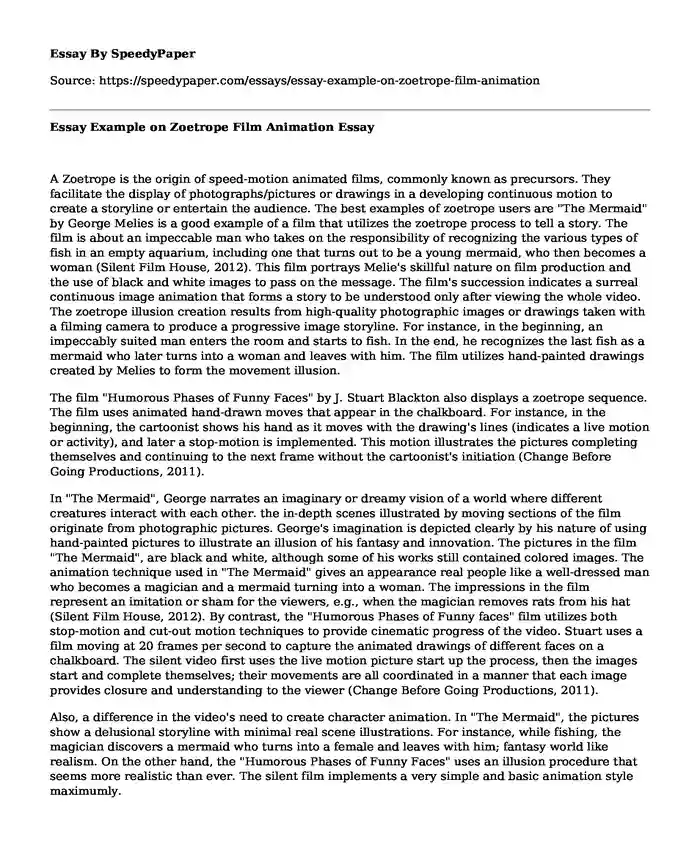A Zoetrope is the origin of speed-motion animated films, commonly known as precursors. They facilitate the display of photographs/pictures or drawings in a developing continuous motion to create a storyline or entertain the audience. The best examples of zoetrope users are "The Mermaid" by George Melies is a good example of a film that utilizes the zoetrope process to tell a story. The film is about an impeccable man who takes on the responsibility of recognizing the various types of fish in an empty aquarium, including one that turns out to be a young mermaid, who then becomes a woman (Silent Film House, 2012). This film portrays Melie's skillful nature on film production and the use of black and white images to pass on the message. The film's succession indicates a surreal continuous image animation that forms a story to be understood only after viewing the whole video. The zoetrope illusion creation results from high-quality photographic images or drawings taken with a filming camera to produce a progressive image storyline. For instance, in the beginning, an impeccably suited man enters the room and starts to fish. In the end, he recognizes the last fish as a mermaid who later turns into a woman and leaves with him. The film utilizes hand-painted drawings created by Melies to form the movement illusion.
The film "Humorous Phases of Funny Faces" by J. Stuart Blackton also displays a zoetrope sequence. The film uses animated hand-drawn moves that appear in the chalkboard. For instance, in the beginning, the cartoonist shows his hand as it moves with the drawing's lines (indicates a live motion or activity), and later a stop-motion is implemented. This motion illustrates the pictures completing themselves and continuing to the next frame without the cartoonist's initiation (Change Before Going Productions, 2011).
In "The Mermaid", George narrates an imaginary or dreamy vision of a world where different creatures interact with each other. the in-depth scenes illustrated by moving sections of the film originate from photographic pictures. George's imagination is depicted clearly by his nature of using hand-painted pictures to illustrate an illusion of his fantasy and innovation. The pictures in the film "The Mermaid", are black and white, although some of his works still contained colored images. The animation technique used in "The Mermaid" gives an appearance real people like a well-dressed man who becomes a magician and a mermaid turning into a woman. The impressions in the film represent an imitation or sham for the viewers, e.g., when the magician removes rats from his hat (Silent Film House, 2012). By contrast, the "Humorous Phases of Funny faces" film utilizes both stop-motion and cut-out motion techniques to provide cinematic progress of the video. Stuart uses a film moving at 20 frames per second to capture the animated drawings of different faces on a chalkboard. The silent video first uses the live motion picture start up the process, then the images start and complete themselves; their movements are all coordinated in a manner that each image provides closure and understanding to the viewer (Change Before Going Productions, 2011).
Also, a difference in the video's need to create character animation. In "The Mermaid", the pictures show a delusional storyline with minimal real scene illustrations. For instance, while fishing, the magician discovers a mermaid who turns into a female and leaves with him; fantasy world like realism. On the other hand, the "Humorous Phases of Funny Faces" uses an illusion procedure that seems more realistic than ever. The silent film implements a very simple and basic animation style maximumly.
Other than that, Georges' record features three-dimensional hand-painted drawings or paintings which facilitates message passage more effectively. According to Sekeroglu, (2013 pg. 814), the three dimensional gives more value and content to both the viewers and producers. However, even with the artificial world models, The Mermaid uncovers a string of extremely coherent drawings, music, movements, and design that produce a harmonious story by exploiting the 3d animation. The film shows realistic virtual scenes with enough lighting and dramatization to diffuse the complexity of the whole video. On the contrary, the Blackston's shoot has just a one-dimensional animation. The hand-drawn images visibly communicate their message in a simple manner that involves minimalized content. The images themselves are open and direct to ease the process of understanding the message.
The similarities between the two films are that they both utilize hand-drawn images. The creators complement their skill sets by taking several photographs with cameras and turn them into films. Also, they both use the cut-out method to portray their cinematic photography. This means that they use still hand-painted or hand-drawn images (with particular consistency) to produce a systematic message. For instance, in "The Mermaid", the cartoonist starts by showing a live image of an image being drawn. However, what follows are images that start and complete themselves in a progressive manner.
References
Change Before Going Productions. (2011, December). Humorous Phases of Funny Faces (1906) - 1st Drawn Animation - J. Stuart Blackton. Retrieved from https://www.youtube.com/watch?v=LHXzVufTX_8
Sekeroglu, G. K. (2012). Aesthetics and design in three-dimensional animation process. Procedia-Social and Behavioral Sciences, 51, 812-817. Retrieved from https://www.sciencedirect.com/science/article/pii/S1877042812033836/pdf?md5=3c6b950bed2b6e1ad8006e29357e2b41&pid=1-s2.0-S1877042812033836-main.pdf
Silent Film House. 2012, October. The Mermaid (1904) Georges Melies. Retrieved from https://www.youtube.com/watch?v=l-dTU1wKh10
Cite this page
Essay Example on Zoetrope Film Animation. (2023, Jan 13). Retrieved from https://speedypaper.net/essays/essay-example-on-zoetrope-film-animation
Request Removal
If you are the original author of this essay and no longer wish to have it published on the SpeedyPaper website, please click below to request its removal:
- Battle of Britain - Free Essay in History
- Art Essay Examples for Free
- Free Essay on Government Surveillance on Its Citizens
- Essay Sample with Social Media Proposal
- My Education and Career Goals - Free Essay for Everyone
- Article Review Essay Example: Verizon Data Breach Investigations Report 2018
- Essay Sample Dedicated to Handel's Messiah Hallelujah Chorus
Popular categories





